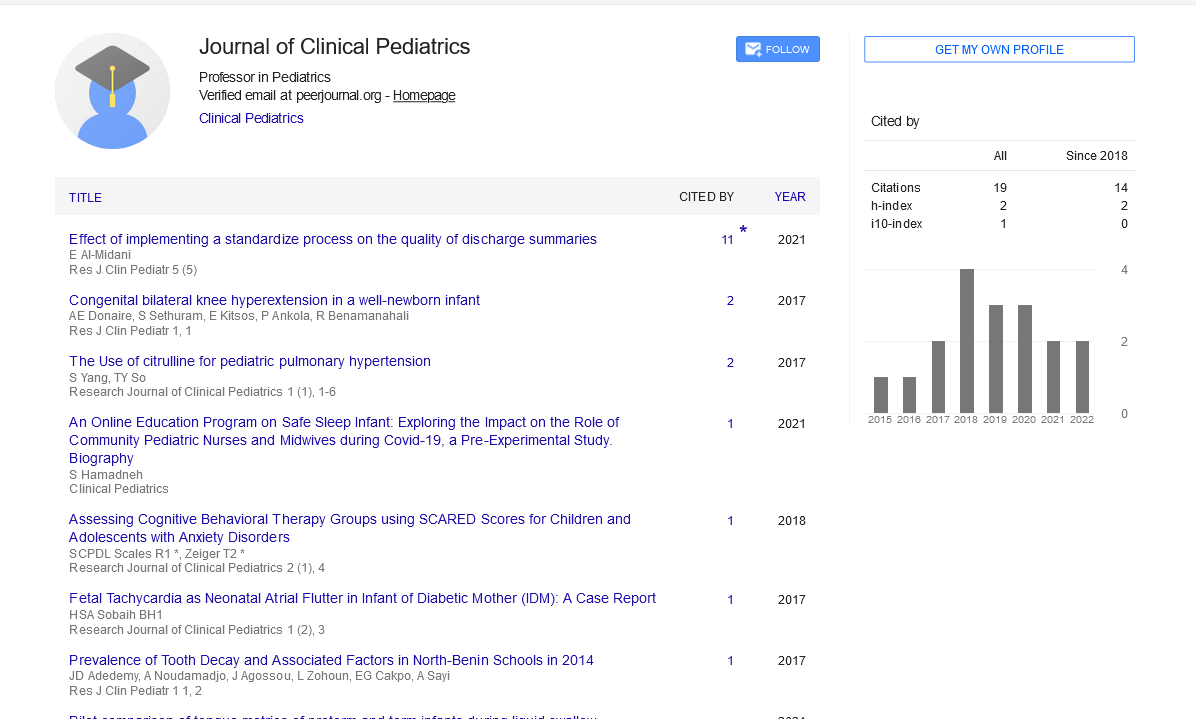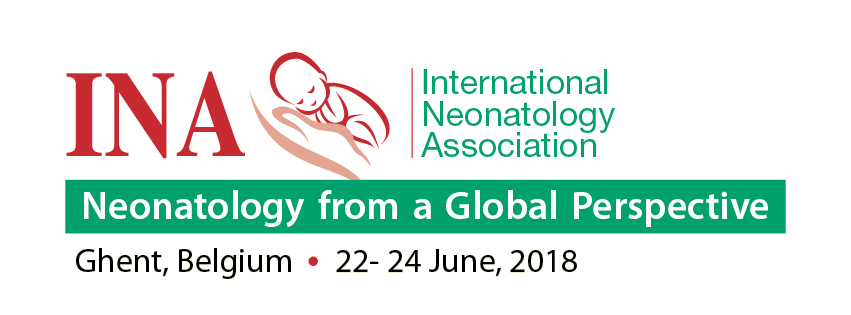Perspective, Res J Clin Pediatr Vol: 6 Issue: 2
A Report of the Clinical Treatment of Non-Syndromic Severe Oligodontia with Implants
Aissani Adeyiga*
Department of Medical Biochemistry, Nile University of Nigeria, Abuja, Nigeria
*Corresponding Author: Aissani Adeyiga
Department of Medical Biochemistry, Nile University of Nigeria, Abuja, Nigeria
Email: adeyigaissani@yahoo.com
Received date: 01 March, 2022, Manuscript No. RJCP-22-59962;
Editor assigned date: 03 March, 2022, PreQC No. RJCP-22-59962(PQ);
Reviewed date: 14 March, 2022, QC No RJCP-22-59962;
Revised date: 25 March, 2022, Manuscript No. RJCP-22-59962(R);
Published date: 01 April, 2022, DOI: 10.4712/rjcp.1000125.
Citation: Adeyiga A (2022) A Report of the Clinical Treatment of Non-Syndromic Severe Oligodontia with Implants. Res J Clin Pediatr 6:2.
Keywords: Severe Oligodontia with Implants
Introduction
Lead poisoning is a serious public health problem that affects children of all ages and causes multi-organ damage. Because of developmental growth and cognitive development at this critical time of life, it has been established that there is no little amount or considerable quantity of lead exposure that is safe for children. Because of their hand-to-mouth explorative habits at this developmental period, children are at a very high risk of inadvertent lead intake. Lead poisoning has been linked to learning difficulties, Low Intelligence Quotients (LIQs), attention deficits, and behavioral issues. Even at modest levels of lead poisoning, mounting research suggests that lead poisoning has an irreversible, negative impact on a child's development, resulting in learning and behavioral issues as well as a reduced attention span. Furthermore, the affected patient experiences symptoms such as abdominal pain, loss of appetite, renal functions impairment, and anemia as a result of the inhibition of the production of the oxygen-carrying protein hemoglobin. Furthermore, due to epigenetic change, childhood lead poisoning may develop into neurological disorders such as Parkinson's disease and Alzheimer's disease in the future. Between 1960 and 2019, a literature search method was utilized using electronic databases. "Lead poisoning in children" or "blood toxicity of lead in childhood" was the search terms utilized. The quality of the literature was determined by selecting publications that were related to the topic of my talk using the Agency for Healthcare Research and Quality's criterion (AHRQ). There were 2778 articles found in the search. Only relevant articles were chosen for the purpose of the issue being investigated from the research findings collected.
Toxic Effect in Environmental Pollution
According to the facts shown above, lead poisoning and toxicity among children constitute a global burden of disease as a result of today's emerging industrial activity. The goal of this review study is to identify the impact of lead toxicity on children in the pediatric age group, as well as the societal cost it places on them, as well as possible policy and education awareness to help minimize the threat. Because lead is a dangerous metal that pollutes the environment, its presence in the blood has been linked to major health problems. It's been defined as a poisonous heavy metal that can harm human organs and tissues, especially during the development of the Central Nervous System (CNS). Most notably, lead exposure has been linked to learning difficulties, Low Intelligence Quotient (LIQ), attention deficit, and behavioral disorders in children under the age of eight. Even low levels of lead poisoning have been linked to irreversible, negative impacts on a child's development, including learning and behavioral issues, as well as a proclivity to commit crimes.
Children absorbed approximately 50% of consumed lead, compared to adults who absorbed approximately 20% of ingested lead. This could explain why some of the affected youngsters have a higher degree of negative effects. The half-life of lead in an adult is thought to be 28 days. There is no available information supporting the halflife of ingested lead in the pediatrics group. Lead poisoning can cause convulsions, unconsciousness, and even death at large doses. Poisoning is a common type of unintentional injury in children, and it is associated with high mortality and morbidity. It's worth noting that the vast majority of today's children's toys have been found to contain a higher amount of lead, which has been shown to have a substantial negative impact on children aged one to eleven years. There is currently no recognized low level of blood lead in pediatrics that can be used to diagnose lead poisoning and toxicity. What this review tries to establish is the need for a proactive approach of diagnosis in the pediatric age group, as well as a timely monitoring of lead levels in their blood. Because of the high rate of industrial production of leadcontaining products, contaminated sea foods, and contamination of food substances via food agricultural produce from already adulterated soil from plants and crops, making blood lead level a routine medical laboratory test will be a burden-lifting economic and social measure.
In addition to the personal harm caused by lead poisoning, society as a whole bears a significant social and economic burden. The level of lead in a child's blood is used to make a diagnosis. Lead poisoning is defined as a blood lead level, according to the American Academy of Pediatrics. According to the research of Min-Ming Li and his colleagues, there is a clear link between the economic condition of the affected children and the prevalence of lead poisoning in children of all ages. The most significant barrier to preventing lead poisoning is a lack of public awareness and education about the dangers of lead poisoning from diverse human activities. Lead poisoning can be avoided by raising awareness among clinician-scientists in rural and industrial locations, as their work is more widely recognized and promoted with less effort. Furthermore, there is a long history of human exposure to lead in meals and beverages. Lead poisoning became frequent in the early 19th and early 20th centuries among employees whose jobs included smelting, painting, printing, and a variety of other industrial tasks.
Pathophysiology of Lead and its Metabolism
Lead is a toxin found in almost every environment that has the potential to harm the growing brains of children. The amount of lead absorbed depends on a number of parameters, including the particle size, the individual's age, the route of exposure, the individual's health, and nutritional status. The mechanism of action for how lead induced poisoning damages specific tissue organs is still a bit nebulous. Oxidative stress induction, direct apoptic process activation on neural cells, interference dependent enzymes, and the calmodulin signaling pathway is all known biological processes. The activation of the Gprotein coupled receptor with stimulation of the calcium voltage gated channel is the molecular mechanism of lead-induced toxicity. This process causes the endoplasmic reticulum to release stored material Furthermore, this encourages calmodulin, a calcium sensor protein, to enter and bind. Furthermore, the displacement of calcium binding sites causes phosphorylation of protein kinases, which causes gene transcription and enzyme activity, causing even more damage to cellular tissues by triggering inflammatory and immunological responses. The neuro pathological effect, on the other hand, causes astrocytes and endothelial cells to lose their neuronal cell tissue architecture. The flow of plasma into interstitial spaces causes brain edoema and encephalopathy, which leads to increased intracranial pressure and, as a result, brain damage. Lead poisoning causes proximal convoluted tubule dysfunction, which causes aminoaciduria, glycosuria, and hyper phosphaturia in children, resulting in fanconi syndrome. Lead toxicity has a severe impact on vitamin metabolism, and vitamins play a crucial part in children's growth and development
Effects of Lead Toxicity on Various Organ Systems
Acute exposure to high amounts of lead has recently been linked to encephalopathy and neuropsychological problems. Because the immature endothelial cells that form the capillaries of the brain offer a considerably lower resistance to lead, the fetus astrocytes in utero are at a high risk of lead poisoning, the fetus astrocytes in utero are at a high risk of lead intoxication. Intracellular lead then takes the position of calcium as a second messenger by binding to calmodulin more quickly than calcium, causing a change in protein structure. Gastrointestinal stomach pain, anorexia, vomiting, and constipation are all frequent in children. Renal initial high-dose lead exposure can cause proximal tubular dysfunction, and interstitial nephritis can develop after repeated exposures. This could play a role in the initiation and progression of hypertension, especially with increasing levels of exposure.
The destruction of erythropoietin has been shown to play a significant role in anemia. Hematologic lead poisoning disrupts him in production over time by blocking several enzymes, resulting in microcytic anemia. As a result, with sudden massive exposures to lead, hemolytic anemia may occur.
 Spanish
Spanish  Chinese
Chinese  Russian
Russian  German
German  French
French  Japanese
Japanese  Portuguese
Portuguese  Hindi
Hindi 
